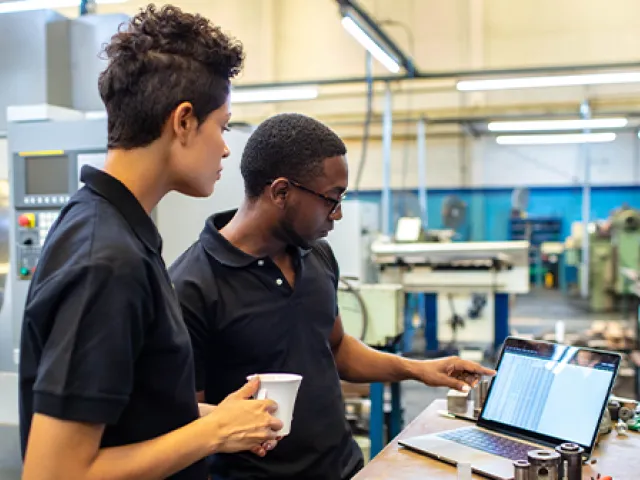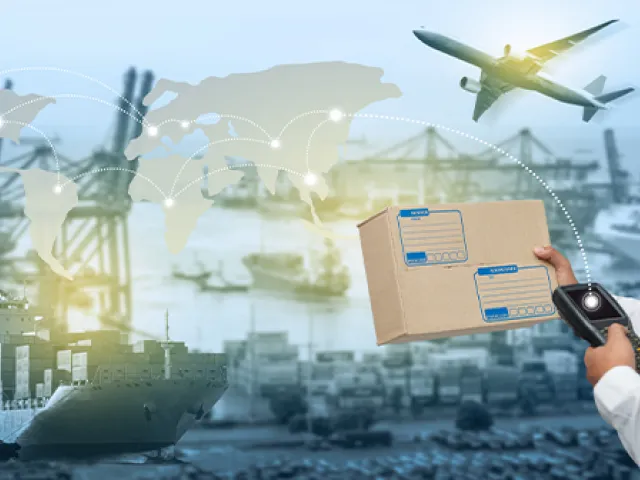Table of contents

Seamless process automation is essential for driving efficiency, ensuring predictability, and creating win-win relationships between external manufacturers and their brand owner customers. But the first step is getting your ERP house in order, according to Arun Giddu, Director of Supply Chain at Thermo Fisher Scientific.
In this episode of Orchestrating Outcomes, Giddu sits down with Sarang Deshpande, Business Manager for External Manufacturing Orchestration at TraceLink, to discuss why a well-implemented ERP system and a robust layer of master data is the key to achieving return on investment for supply chain digitalization initiatives. Without this groundwork, digitalization can struggle to deliver value, leaving companies stuck with outdated and error-prone manual processes.
Key topics:
- Insights on building an ERP and master data foundation to support reliable, automated processes.
- Strategies to close the gap between digital ambitions and the current reality of fragmented information exchange, which is reliant on spreadsheets and emails.
- How digitalization empowers CMOs and CDMOs to meet customer demands for timely, high-quality products, while improving margins.
- Key barriers to digital adoption, from high costs and ROI concerns to competing project priorities.
Watch Part 1 now to learn what it takes to build the right foundation for supply chain digitalization. And don't forget to watch Part 2 of our interview with Arun Giddu to get a step-by-step guide on how to measure the success of a supply chain digitalization initiative.
Video Highlights:
- 02:43 - What does 'supply chain digitalization' mean to you?
- 07:51 - How can we close the gap between digitalization goals and today’s info-exchange inefficiencies?
- 10:30 - What are the benefits of digitalization for CMOs and CDMOs?
- 15:27 - What challenges prevent CMOs and CDMOs from starting their digitalization journey?
TRANSCRIPT
TRANSCRIPT
Welcome to another episode of Orchestrating Outcomes. This time for external manufacturing, brought to you by TraceLink. We hope to uncover some key nuances between a CDMO, or a CMO, and their customers, brand owners, as it relates to supply chain digitalization.
I'm thrilled to have with me today Arun Giddu, the Director of Supply Chain at Thermo Fisher. I have known Arun for almost 13 years now. In fact, I reported to him at VWR International, a life sciences company focusing on lab supplies distribution.
With the nature of the business that they had, we worked on several supply chain optimization projects. And one of the key initiatives that we worked on was electronic integration with our supplier base. We had roughly 10,000 purchase orders that we exchanged on a daily basis with our suppliers. So, it was near impossible to not have a digital highway connecting our system to our suppliers and have smooth operations.
So, I'm pleased to reconnect with Arun in a different role now and see if we can explore challenges and opportunities as it pertains to supply chain digitalization in the pharmaceutical industry.
And without further ado, I would like to hand it over to Arun, who can give his brief introduction on his background, roles, and responsibilities he has had in his career. Over to you, Arun.
Hi Sarang, great to be here. As you know, I am a software developer turned supply chain professional, and my interests are in making the supply chain smooth and predictable. I remember vividly, one of my supply chain professors used to end every class by banging the table and saying, "Variability is the enemy!"
And having worked at many distributors and manufacturers, both the big as well as small, I've come to realize how right he is. And supply chain digitalization is one way of making the supply chain smooth and predictable, and let's talk about how we can do that.
Yeah, I mean, I totally echo your thoughts. But one quick question, right? We hear this phrase 'supply chain digitalization' being thrown around quite a few times. What does it mean? Or can you define what supply chain digitalization means to you?
Yeah. So, I think these are actually very deep waters. So, let's take it piecemeal, right? Digitalization is just using computer automation for your processes. So, having your processes being executed by the computer. So, that automatically means that it is error-free and predictable.
Supply chain digitalization just means adding this process automation to your interactions with your customer as well as interactions with your suppliers. Right? So, having said all of that, the ERP implementation has to be right for all of this to happen. Right?
So, I will be be a little bit prescriptive here and maybe a little bit detailed because I have seen many ERP implementations which have not gotten the return on investment, which kind of throws cold water on the enthusiasm for connectivity with the suppliers or connectivity with customers, because your own implementation has not brought you the return on investment that you need. Right? So, this implementation has to be done right, which means that we need to build a layer of master data. Correct? And then build processes on top of that.
Now, this is easier said than done. But I think if you focus on just two things, the path to the right kind of implementation of ERP will be self-guided. The two things you need to focus on is customers, right? Will this help the customer?
And then the second thing is your aspiration. What is it that you want to achieve by automating processes? So, for example, my thinking is about lights-out manufacturing.
That means your processes are so automated that you do not even need lights for your manufacturing process to happen. If that is your aspiration and you are customer-focused, then you'll be self-guided at every fork in the intersection. You will make the right decision because you are asking only two questions. Will this be helpful to my customer? And second is, will this help me towards lights-out manufacturing?
Now, lights-out manufacturing may be 50 years out, maybe 100 years out, or maybe it's a never-in-my-lifetime kind of a thing, or in any lifetime. But the thing is if you aspire to that, you will move in the right direction. It's just like somebody said, right? If you reach for the stars, you'll land on the moon.
If you aspire towards lights-out manufacturing and think about the customers at every step of the way, you will be self-guided and your MRP implementation will give you the return on investment. But then the next step about connecting with the suppliers and customers and having that process automated becomes a natural extension and there will be enthusiasm in the organization for that.
Yeah. This makes total sense. And I still remember one of your statements that you always used to make. "Hey, we should aim to get to a point where machines are doing what machines are meant to do and let humans do the job that humans are better at doing. Let's not mix their roles and responsibilities."
Which kind of brings me to another topic, which we are hearing a lot these days, which is all about AI and machine learning and trying to have machines do a human job also. But I think one of the basic foundations of being able to do that is to have a good data foundation.
And what I see in a lot of the organizations, even multibillion dollar organizations, is that they are still exchanging critical supplies and information through spreadsheets and emails and PDFs. There is a big disconnect between what the aspiration is and what the current reality is. Why do you think there is this gap and what can we do to reduce this gap?
Yeah, as I had said earlier, if they have not gotten the return on investment on the MRP investment, then they will be less likely to have electronic connectivity with customers and suppliers. So, I think the first step is to make sure that they have the right MRP system.
And the second thing also is showing the return on investment to spur investment into digital connectivity. Right? I remember, as you might remember, SAP does a great job in coming up with the ROI calculators and talking to you and then coming up with numbers that say: "OK. You will be so much better off if you were to use our system because you will get this return on investment."
Right? So, similarly, I think we should be able to show the return on investments on digital connectivity with customers and suppliers. And I think that will go towards making the leap from emails and things like that to being digitally connected.
So, every business, I think we should assume that they are rational. And any rational businesses would want a return on investment. They are not going to spend money when the returns are not guaranteed or almost guaranteed, right?
They want assurance that this money is not going to be wasted. And especially if their MRP implementation has not gotten them a big return on investment, the job becomes even more difficult. I agree. This is something that I was asked a lot of times in my previous organization.
They said, "Hey, what are you trying to achieve? And why are you trying to achieve it? Show me the ROI because you only have limited resources and time to implement a variety of projects that we are trying to implement. So, we are going to prioritize the one that gives us the highest return on investment."
So, I think you have hit the nail there that we need to be able to justify and come up with the right return on investment calculations before we initiate that project.
How do you see that this supply chain digitalization can help CMOs or CDMOs specifically? Every organization has their own reasons for undertaking this and they have their own goals. So, where do you see CMOs or CDMOs benefiting from supply chain digitalization?
Yeah, especially CMOs, right?
One of the things you want to do through supply chain digitalization is to be more efficient. And especially with the CMOs, your customer knows almost everything about your operation because many times they might own the process.
Many times they will also dictate which supplier you need to get raw materials from. Sometimes even the prices of the raw materials that you get from the suppliers are fixed by the customer. So, they know a whole lot about you.
So, then your ability to make a good margin gets reduced because they know everything about you and they can always challenge you. So, then you make your margins by being very efficient and digitalization is one way of being very efficient.
The other thing also about this digitalization is also if this connectivity helps the customers. Because think about it: Every customer wants to know when their stuff is going to be delivered, right? They want quality products at the right time and at the right price. And if you are efficient, then you will be able to provide this. And also they want the information on: Hey, when is my product going to arrive?
And if it's not going to arrive on time, they would like to be informed. These kinds of interactions are helped if we have connectivity. Like, for example, POs sent automatically: As soon as there is a need for an item, a PO is sent out. And then a PO acknowledgment, which tells you that this product is going to ship on this day.
And then if it doesn't ship, another one saying that it is going to ship on this day, so that the customer knows at every point of time, when they are going to get their product. So, that is something which the customer wants. So, if you can provide them what they want and make the customer stick, make the stickability higher, and then you are also very efficient.
Therefore, you are able to give them the right product at the right time with the best possible quality, then both you and the customer win. Yeah. And this takes me back to the last project that we worked on together, which was, where is my stuff? Customers always kept asking that. I'm not overly worried about the products that you have already delivered.
But for the ones which you have not, tell me when is it going to arrive and keep me posted about any updates, any delays that are happening. So, I think that's a very important point. One thing I want to interject here is that I've seen companies spend an inordinate amount of time and effort giving them this information.
You have to create these spec sheets, get the information from various sources, and then send them. And then, at multiple levels, they will ask for that information because your performance is not good because you're not efficient. And therefore everybody wants to know, ok, when is my stuff going to be here? So, you will get questions from the VP level to the buyer level because they all want to know, hey, where is my stuff? Right?
So, and that is going to make your organization much less efficient because we are running around trying to scrape this information, put it in an Excel spreadsheet and send it across. That's very time consuming and then also it is likely to be not consistent. And then the customer is going to trust you less and then, again, more questions will come in. So, efficiency is going to go down if your interaction is in this manner. And I've seen this very, very often. Yeah, yeah. It's almost a vicious spiral which you almost can never get out of.
But I mean, given that there are so many obvious benefits of doing digital integration with customers: What are some of the factors that currently are inhibiting or are behaving as a roadblock for CMOs or CDMOs from undertaking this journey? Is it the cost of implementation? Is it the speed of implementation? Is it scalability? What's really stopping them from getting on this journey?
I mean, it could be multiple factors, right? One is that they do not yet see the return on investment, which we have already covered. The other thing is, they may have projects which they are currently working on that show them a bigger return on investment.
So, the typical way to judge projects is: I have all of these projects. Let me do the ones with the largest NPV. So, it's up to companies like TraceLink to show that there is a lot of NPV here, for them to say, "OK, we will undertake this project." And the other thing that might be a roadblock, or a hindrance, or basically, it's not on top of mind of the people making the decisions, is that maybe their margins are pretty good.
Remember, when we went the way of digitalization at VWR: We are a distributor, a lot of competition, margins were tight. So, there used to be a lot of incentive to be really efficient. And then because we had a lot of customers, the only way to be efficient with such a large number of products and a large number of customers is by going digital.
And it is very much possible that these things do not apply, or are not on top of mind, for the executives to make that decision. Right? So, I think it all goes back to reinforcing the return on investment. There is a significant value that you can realize by undertaking this journey.








